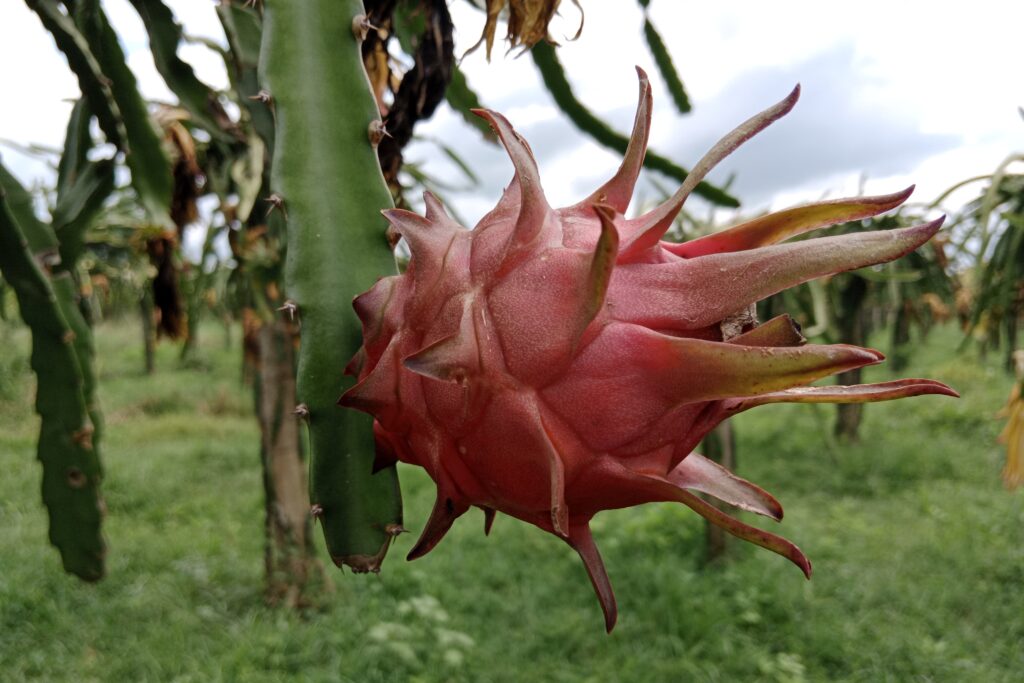Cassava Farming
Cassava (Manihot esculenta), commonly known as yuca or manioc, is a perennial woody shrub cultivated mainly for its starchy tuberous roots. It serves as a staple food for millions of people in tropical and subtropical regions and also plays a significant role as an industrial crop, being used for starch, biofuel, and animal feed production. The crop is highly valued for its resilience, particularly its drought tolerance and ability to perform well in marginal soils, making it a reliable source of food and income in challenging environments.

Cassava farming profit per acre highlights the remarkable economic potential of this crop, positioning it as a highly profitable agricultural venture. With an estimated investment of NRs. 56,000 per acre, farmers can generate an income of NRs. 225,000, resulting in a net profit of NRs. 169,000. This equates to a profit margin of 75.1% and a return on investment (ROI) of 302%, meaning that every NRs. 1 invested yields a return of NRs. 3.02 after expenses. These figures clearly demonstrate that cassava farming is not only financially viable but also one of the most lucrative opportunities available to growers.
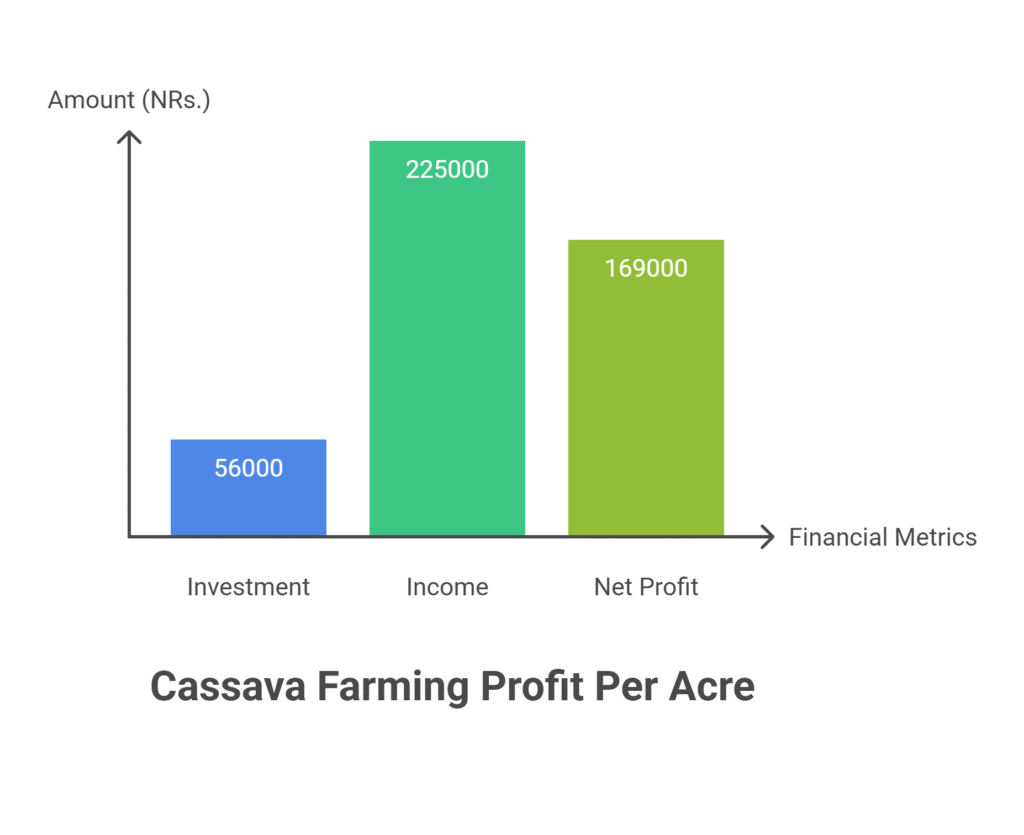
Land Preparation
Land preparation is done for cassava cultivation in order to guarantee loose, weed-free, well-aerated soil that facilitates easy root penetration and growth. In order to soften compacted soil, which is necessary for proper root development, the field must first be cleared of trees, stumps, bushes, and leftovers from prior crops. This is followed by thorough plowing up to 20 to 25 cm (8 to 10 inches). To break up big clods and produce a fine tilth that is ready for planting, plowed soil is then harrowed once or twice. Forming ridges or mounds is strongly advised in regions that experience frequent heavy rains or inadequate drainage because it reduces root rot, prevents waterlogging, and facilitates harvesting.
Soil Type
Although cassava can withstand acidic conditions as low as pH 4.5, it thrives in well-drained sandy loam or loamy soils with a pH of 5.5 to 6.5. It does not do well in alkaline soils. Cassava is a critical crop for food security because of its versatility, which allows it to flourish even in low-fertility, poor soils where many other crops fail. However, it is also sensitive to saline or wet conditions, which significantly impairs its growth.
Climatic Requirements
While development is significantly hampered at temperatures below 10°C (50°F), cassava thrives in a warm, frost-free environment with ideal temperatures between 25°C and 29°C (77°F and 84°F). Though its deep root structure enables it to tolerate dry spells of 4–6 months, with diminished yields, it thrives in moderate, evenly distributed annual rainfall of 1000–1500 mm (39–59 inches). Since cassava cannot withstand shade, it need full sun for optimal yield.
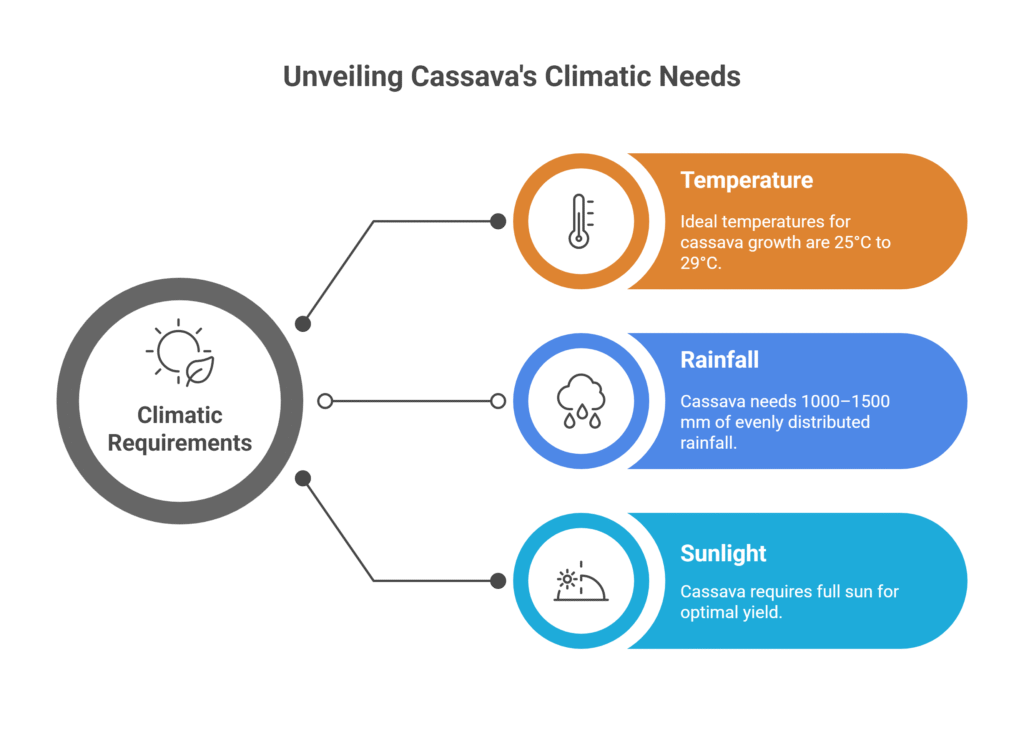
Major Cultivars
Cassava cultivars are generally categorized as “sweet,” which have low cyanogenic content and are suitable for direct human consumption, or “bitter,” which contain higher cyanogenic levels and require processing for starch extraction and industrial use. Improved varieties include the Tropical Manihot Selection (TMS) series such as TMS 30572 and TMS 4(2)1425, known for high yields and disease resistance, as well as Cassava Mosaic–resistant varieties like TME 419, widely grown in Africa for its productivity and resistance to mosaic virus. In addition, many regions maintain local farmer-preferred varieties that are often adapted to specific pests, growing conditions, and consumer preferences.
Propagation
Cassava is primarily propagated vegetatively through stem cuttings rather than seeds, with cuttings taken from the mature, woody portions of healthy, pest- and disease-free plants aged 8–18 months. These stems are prepared into setts or stakes measuring 15–25 cm (6–10 inches) in length, each containing 5–8 nodes, and must be handled with care to prevent drying out and planted promptly after cutting to ensure successful establishment.
Seed Rate per Acre
The seed rate for cassava depends on the chosen spacing, but on average, about 5,100 stem cuttings are needed to plant one acre, which typically requires stems harvested from around 300 to 500 mature cassava plants from the previous crop.
Nursery Management
Although cassava is usually planted directly in the field, nursery management can be practiced to multiply scarce planting material or to secure a good plant population when direct planting has a low success rate. In this method, stem cuttings are planted closely in a protected nursery bed, watered regularly until they sprout, and then transplanted to the main field for further growth.
Planting
a). Planting Season
Planting is timed to coincide with the onset of the rainy season to ensure good sprouting and initial growth. It can be planted year-round with irrigation.
b). Spacing
Cassava spacing varies with soil fertility and the intended purpose of cultivation, whether for root production or stem multiplication, but a common recommendation is to plant at 1 meter between rows and 0.8 meters between plants.
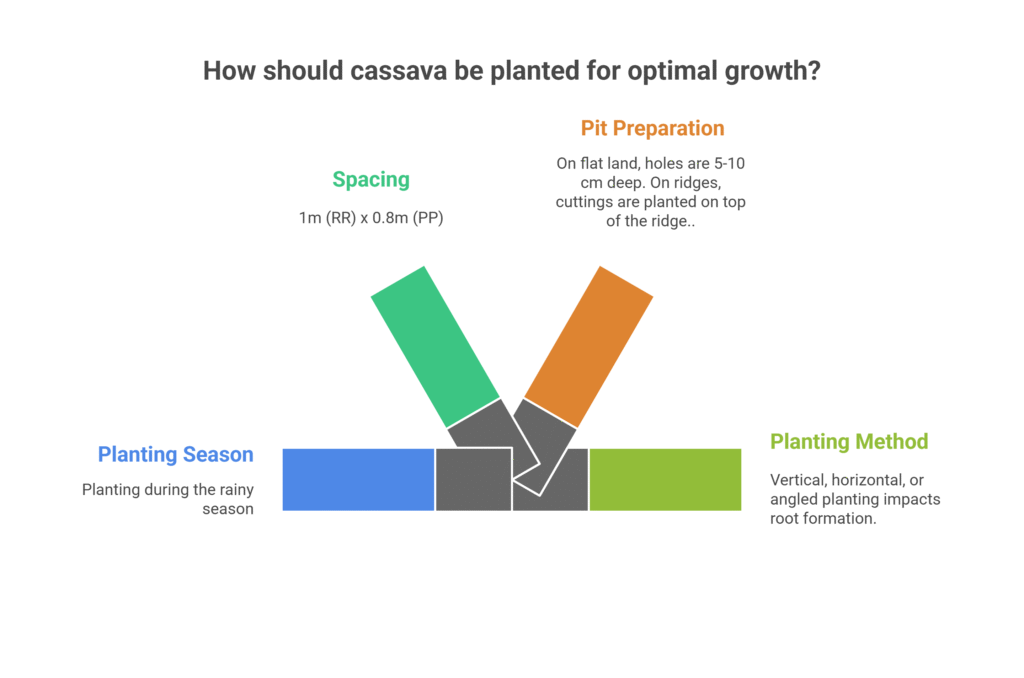
c). Pit Preparation
Small holes are made at the recommended spacing. On flat land, holes are 5-10 cm deep. On ridges, cuttings are planted on top of the ridge.
d). Planting Method
Cassava cuttings can be planted vertically, horizontally, or at an angle, depending on soil and climatic conditions. In vertical planting, about two-thirds of the cutting is buried upright, which is suitable for moist soils, while in horizontal planting the cutting is laid flat in a shallow furrow and covered with 2–3 inches of soil, making it ideal for dry areas. The tilted or angled method, where cuttings are placed at a 45-degree angle, is the most common and recommended approach as it promotes better root formation and sprouting.
e). Number of Plants per Acre
With a spacing of 1 m × 0.8 m, an acre can accommodate approximately 5,058 plants.
Intercropping
Cassava is highly suitable for intercropping, particularly during the first 3–4 months before its canopy closes. Common intercrops include maize, legumes such as cowpeas, peanuts, and beans, as well as melons and various vegetables. Intercropping cassava offers multiple benefits: it maximizes land use, provides additional income, helps suppress weeds, and enhances soil fertility through nitrogen fixation by legumes, which in turn benefits the cassava crop.
Irrigation
Although cassava is drought-tolerant, it benefits significantly from irrigation, particularly during the first four months after planting and during extended dry periods. The crop has critical water requirements during root initiation (1–3 months after planting) and root bulking (5–7 months after planting). Irrigation can be applied using furrow, drip, or sprinkler systems, with the aim of maintaining soil moisture without causing waterlogging.
Fertilizer and Manure
Cassava is a heavy feeder that particularly depletes soil potassium, essential for root development, making soil testing highly recommended to ensure precise fertilizer application. Fertilizers should be applied in bands positioned 10–15 cm away from the plant base and incorporated into the soil for optimal nutrient uptake.
General Recommendation (per acre)
| Fertilizer Type | Recommendation Details |
| Organic | Apply 8-10 tons of well-decomposed farmyard manure (FYM) or compost during land preparation. |
| Biofertilizers | Apply a mixture of Azospirillum, Phosphorus Solubilizing Bacteria (PSB), and Potash Mobilizing Bacteria, with 800g of each per acre. |
| Inorganic (NPK) | Total: 100-120 kg N, 50-60 kg P₂O₅, and 120-150 kg K₂O per acre. Application: Split into two equal doses—half at planting and the remaining half 6-8 weeks after planting. |
Weed Control
Cassava is severely hampered by weeds, especially in the first three to four months following planting, when the first ninety to one hundred days are crucial for weed control. Cultural, mechanical, and chemical strategies are all used in effective weed management. For example, intercropping with fast-growing crops can suppress weeds, while earthing up and two to three hand weeding sessions at four to six, eight to ten, and twelve to fourteen weeks after planting can assist support plants and cover developing roots. Before weeds appear, pre-emergence herbicides like atrazine can also be sprayed right after planting; however, they should be handled carefully and in accordance with the directions on the package.
Inter Culture Operation
Farmers can consider cassava to be a low-maintenance crop because it typically requires few inter-culture operations. It is easier to manage, especially for smallholders, because it doesn’t require frequent training or trimming like many other crops do.
Pruning is only occasionally necessary. If a cassava plant produces an excessive number of stems, typically more than three to four, the weaker stems can be removed. This practice helps the plant redirect its energy toward root development rather than supporting multiple stems. However, for most small-scale farmers, pruning is not a routine activity.
The most crucial cross-cultural cassava operation is earthing up. During the weeding procedure, earth is piled up around the plant’s base. Earthing up has several benefits, including helping to suppress weeds, supporting the plant and preventing it from lodging, and covering growing roots to stop greening, which can result in the development of harmful substances. A proper earthing up maximizes yield and guarantees healthy root growth.
Flowering and Fruit Management
Cassava plants may produce male and female flowers, but flowering and fruiting are not a focus of management since the crop is cultivated for its roots rather than its small, inedible fruit. Flowering does not significantly affect root yield, and therefore, no specific management practices are required for flower or fruit development.
Pest and Disease Management
Common Pests
a). Cassava Mealybug
This pest feeds by sucking sap from the plant, which leads to symptoms like leaf curling, stunted growth, and reduced tuber yield. Effective management relies on using resistant varieties and introducing biological control agents, such as the parasitoid wasp Anagyrus lopezi. If insecticide application becomes necessary, a soil application of imidacloprid 17.8% SL at 100-150 ml per acre can be effective. Always prioritize biological methods to protect beneficial insects.
b). Green Mite
Green mites cause damage by feeding on the undersides of leaves, resulting in characteristic yellow speckling, bronzing, and premature leaf drop (defoliation). The primary control strategy is to use resistant varieties and to conserve or introduce predatory mite species. In cases of severe infestation, miticides such as abamectin 1.9% EC at 200-250 ml per acre or dicofol 18.5% SC at 600-700 ml per acre can be applied.
c). Whiteflies
Whiteflies are a major concern not only because they suck plant sap but because they are the primary vector for Cassava Mosaic Disease (CMD), a devastating viral infection. The most critical control measure is to plant CMD-resistant varieties. To manage whitefly populations directly, apply neem oil 5% (3000 ppm) at 2-3 ml per liter of water or acetamiprid 20% SP at 60-80 grams per acre.
d). Stem Borers
These bugs’ larvae burrow into the main stems, weakening and making them more brittle. Using healthy, pest-free planting material is the best way to manage a plant. To stop the pest’s life cycle, regularly check the crop and remove and destroy any contaminated stems right away. Once larvae are inside the stem, insecticidal control becomes difficult; however, a prophylactic drench with 1.5 liters of chlorpyrifos 20% EC per acre may be an option.
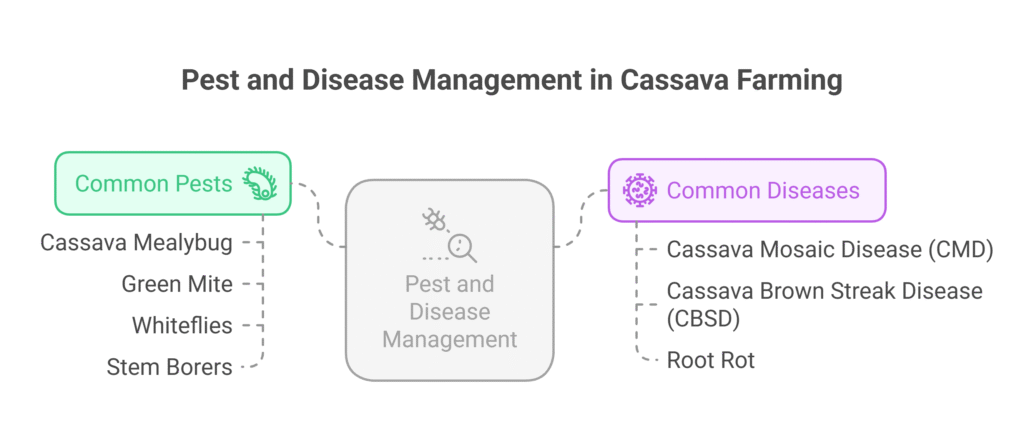
Common Diseases
a). Cassava Mosaic Disease (CMD)
This disease is caused by a virus and is one of the most destructive threats to cassava. Symptoms include a distinctive yellow mosaic pattern on leaves, severe stunting of the plant, and drastic reduction in root yield. Since it is a viral disease, there are no curative fungicides or chemicals. Control relies entirely on preventive measures: planting resistant varieties (e.g., TME 419), using certified virus-free planting stakes, and immediately removing and destroying infected plants (rogueing) to prevent the spread by whiteflies.
b). Cassava Brown Streak Disease (CBSD)
Another devastating viral disease, CBSD primarily affects the roots. It causes dry, brown necrotic streaks within the storage roots, making them unpalatable and unfit for consumption or sale. Like CMD, it cannot be controlled with chemicals. Management focuses on planting tolerant varieties and strictly using clean, certified planting material sourced from disease-free areas. Controlling the whitefly population can also help reduce the spread of the virus.
c). Root Rot
Fungal pathogens found in the soil are the origin of this illness, which causes the root system to rot and disintegrate, killing the plant in the process. It is frequently linked to soggy circumstances and inadequate drainage. Long crop rotations with non-host crops, proper field drainage, and avoiding planting in thick, water-retentive soils are the main cultural control measures. Early detection of fungal root rot can be prevented by a soil drench application of a systemic fungicide such as carbendazim 50% WP (200–250 grams per acre) or thiophanate-methyl 70% WP (150–200 grams per acre). Nonetheless, the most important stage in long-term management is to improve soil conditions.
Harvesting
Maturity Period
The timeline for harvesting cassava is highly variable, typically ranging from 8 to 18 months after planting. This wide range depends primarily on the specific variety planted and the local growing conditions, such as climate and soil quality. Early maturing varieties can be ready for harvest as soon as 8 months, while later-maturing varieties often require 12 to 15 months to achieve their optimal yield and root size.
Harvest Indicators
Knowing when to harvest is determined by observing key physical signs. The plant provides visual cues, such as the yellowing and dropping of its leaves. The most reliable method, however, is to check the roots themselves. Mature roots will be firm and have reached a marketable size, typically 3-6 cm in diameter and 20-30 cm in length. Farmers often perform a trial digging of a single plant to confirm that the entire crop is ready for harvest.
Harvesting Method
The process of harvesting cassava is predominantly manual and labor-intensive. Using a hoe or fork, workers first carefully loosen the soil around the base of the plant to avoid damaging the fragile roots. Once the soil is loose, the entire root system is manually pulled out of the ground. To make this process easier, the stems are often cut back first. While mechanical harvesters do exist, they are not commonly used by smallholder farmers due to their cost and the scale of their operations, making hand-harvesting the standard method.
Yield
A well-managed cassava farm can achieve an average yield of 8 to 12 tons per acre.
Cost of Investment per Acre for Cassava Farming
| S.N. | Categories | Cost (NRs.) |
| 1 | Land Preparation | 15,000 |
| 2 | Stem Cutting & Transportation | 5,000 |
| 3 | Planting | 4,000 |
| 4 | Fertilizers & Manure | 10,000 |
| 5 | Irrigation | 5,000 |
| 6 | Weed Control (Pre & Post-emergence) | 3,000 |
| 7 | Pest & Disease Control | 3,000 |
| 8 | Harvesting | 6,000 |
| 9 | Miscellaneous Costs | 5,000 |
| Total Cost | 56,000 |
Income from Cassava Farming Per Acre
| Particulars | Estimated Yield (Kg/acre) | Market Price (NRs./kg) | Total Income (NRs.) |
| Yield | 9,000 | 25 | 225,000 |
Analysis of Cassava Farming Profit Per Acre
| Item | Value (NRs.) |
| Total Income | 225,000 |
| Total Cost of Investment | 56,000 |
| Net Profit | 169,000 |
| Profit Margin | 75% |
The net profit from cassava farming per acre is calculated by subtracting the total investment cost (NRs. 56,000) from the total income (NRs. 225,000), resulting in a net profit of NRs. 169,000. This translates into a profit margin of 75.1%, which reflects an exceptionally high level of profitability. Furthermore, the return on investment (ROI) stands at 302%, meaning that for every NRs. 1 invested, the farmer earns back NRs. 3.02 after covering all costs, highlighting cassava farming as a highly rewarding and financially viable venture.
Crop Calendar for Cassava Farming
This calendar outlines the key activities and their approximate timing for a typical cassava crop cycle, which spans 8 to 18 months depending on the variety and purpose.
| Time (Months After Planting – MAP) | Growth Stage | Key Activities & Operations |
| 0 (Pre-Planting) | Land Preparation | • Clear land of previous crop residues, stumps, and bushes. • Plow to a depth of 20-25 cm. • Harrow to achieve a fine tilth. • Form ridges or mounds in areas with heavy rainfall. • Incorporate well-decomposed Farmyard Manure (8-10 tons/acre). |
| 0 (Planting) | Planting | • Source healthy, pest-free stem cuttings from 8-18 month-old plants. • Prepare cuttings into 15-25 cm stakes with 5-8 nodes. • Plant at the onset of the rainy season. • Use a spacing of 1m x 0.8m (approx. 5,000 plants/acre). • Apply first half-dose of inorganic NPK fertilizer and biofertilizers. |
| 0 – 4 MAP | Sprouting & Early Growth | Weeks 1-4: Ensure adequate soil moisture for sprouting (irrigate if necessary). Weeks 4-6: Perform first manual weeding and earthing up. • Monitor for pest outbreaks (mealybugs, whiteflies). • Practice intercropping with legumes or vegetables. |
| 4 – 8 MAP | Canopy Closure & Root Initiation | Weeks 8-10: Perform second manual weeding and earthing up. • Apply the second half-dose of inorganic NPK fertilizer (6-8 weeks after planting). • Critical period for irrigation to support root initiation. • Continue monitoring for pests and diseases (CMD, CBSD, mites). |
| 5 – 7 MAP | Root Bulking | • This is a critical period for moisture. Ensure irrigation during dry spells to maximize tuber growth. • Continue pest and disease surveillance. |
| 8 – 18 MAP | Maturation | • Reduce irrigation to allow roots to mature. • Monitor plants for maturity indicators: yellowing leaves and firm, large roots. • Perform a trial dig to check root size and quality before full harvest. |
| 8 – 18 MAP | Harvesting | • Harvest when roots have reached maturity (8 months for early varieties, 12-18 for later ones). • Cut stems back first. • Loosen soil around roots with a hoe or fork and pull out manually. • Handle roots carefully to avoid bruisin |
Sources
Food and Agriculture Organization (FAO)
University of California Agriculture & Natural Resources (UC ANR)
European Plant Protection Organization (EPPO)
Punjab Agricultural University (PAU)
Tamil Nadu Agriculture University (TNAU) – Agritech portal
Indian Council of Agricultural Research (ICAR)
Nepal Agricultural Research Council (NARC)
U.S. Department of Agriculture (USDA).
Ministry of Agriculture and Livestock Development (Nepal)
Disclaimer: This crop farming profits assume optimal conditions. Actual results may vary depending on climate, market prices, and farm management practices.

